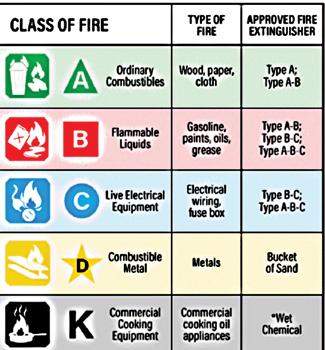
4 minute read
Ounce of Prevention with Mike Teague
Ounce of Prevention:
Understanding Fire Extinguishers
Advertisement
By Mike Teague
Having worked in local fire service for the past thirty-seven years I have been asked many questions about safety in general and specifically many questions on fire safety. One aspect of fire safety in which people have basic questions and concerns is which fire extinguisher to buy. Additional questions usually revolve around how to use the extinguisher and how to tell if the extinguisher is still functional. The goal of this article is to provide you with a general understanding of how to choose the correct fire extinguisher and, should the need ever arise, how to safely use the extinguisher. To get a better understanding as to which fire extinguisher best suits your needs, we need a refresh on what many of us were taught in high school science class: the classes of fire. A basic understanding of the classes of fire will help in the selection of the correct fire extinguisher.
What are the classes of fire?
Class A – Ordinary or common combustibles: Items such as wood, paper and plastics—most of the stuff in our houses. These items are best extinguished by water or some type of extinguishing powder. CO2 extinguishers don’t work well on this class of fire due to the porous nature of the material.
Class B – Combustible and flammable liquids and gasses: Items like gasoline, kerosene, fuel oil, and propane. The use of water on these items would most likely increase the danger of the fire by spreading or moving the fire. These items require some type of extinguishing powder, CO2 extinguisher or specialized foam.
Class C – Electrically energized equipment: Any appliance or item that is on fire and is also electrically energized, including computers, TVs, home appliances and electrical outlets. The use of water on these items would create a shock hazard. These items require an extinguishing agent that will not conduct electricity.
Classes A, B and C will cover most every type of fire that you will encounter in the home. There are two more classes of fire that will more often be found in commercial/business settings.
Class D – Combustible metals: Specialty metals such as magnesium, titanium and aluminum. The use of water on these item may increase the size and intensity of the fire. These metals require a specialized fire extinguishing agent.
Class K – Commercial Cooking Equipment: The oils used in this equipment are volatile and are often used at high temperatures. The use of water of these fires will spread the fire and increase the danger. These fires require a special liquid extinguishing agent that cools as it extinguishes to prevent re-ignition.
Which type of extinguisher is best?
You will want to match the extinguisher type with the hazard that you need to protect. Let’s deal with the two specialty classes first. The majority of the public will not need to be concerned with Class D and Class K hazards, which require a specific extinguisher designed only for those hazards. These extinguishers aren’t effective on any of the other classes of fire, and they may require special training (see graphic).
Most fire hazards in the average home will fit into one of the three basic classes, A, B or C. Since these three classes cover 99 percent of the hazards in our homes, an “A-B-C” multi-purpose extinguisher may be the best and cheapest choice to buy. However, while that may seem simple, you’ll need to read the fine print on each extinguisher to make sure you have the extinguisher you need, in the location you may need it. All extinguishers are clearly marked to indicate the class of fire they will extinguish. Thankfully, extinguishers also include pictorials and symbols that are easy to recognize in an emergency—please refer to the graphic.
Is my extinguisher still good?
When you go to check your extinguisher, you will want to look at the gauge to make sure it is properly charged and ready for use. If the extinguisher is properly charged, the needle in the gauge will be located in the small pie shaped portion on the face of the gauge. If the gauge reads zero, there won’t be enough pressure to push the extinguishing agent out and onto the fire. If during a fire emergency you look at the gauge and the pressure is on zero, set the extinguisher down and get away from the fire.
Before discharging the extinguisher on the fire you will want to look at the pictorials or symbols and make sure it will work on whatever is burning. If it isn’t designed for the class of fire you have encountered, set the extinguisher down and get away from the fire.
How do I use a fire extinguisher?
Several years ago the National Fire Protection Association developed an acronym to simplify the fire extinguisher instructions: PASS
P = pull the pin. The pin is located in the handle and is there to prevent an accidental discharge.
A = aim the nozzle. You will want to aim the nozzle at the base of the fire. The “base” is where the fire is burning from.
S = squeeze the handle. Squeeze both handles together.
S = sweep the fire. Use a sweeping motion from side to side until the fire is completely out.
It is difficult to cover every aspect of fire extinguisher purchase, use and maintenance in an article. Therefore, if you have questions, feel free to reach out to me at Mike.Teague@townofboone.net or your local community fire department or fire marshal.
*Class K extinguishers may require specific training, including when they should be used. For example, the extinguishing agents in many Class K extinguishiners are electrically conductive and should only be used after electrical power to the kitchen appliance is turned off.
Frequent CML contributor Michael Teague is the Assistant Chief of the Boone Fire Department.










